Arro
is one of those diecast toy makers about whom we know very
little. We know that they made two rather nice diecast vehicles
around 1948 - a Commer Van and Austin Seven Racer - but beyond that,
the name has not turned up in any of my researches in trade magazines
or directories, so there is no firm information about where they were
based or whether there was any connection with other diecast toys.
The
only clue that I can offer is that all the Arro vans that have
passed through my hands seem to have come from Yorkshire. In 1986
I bought two pale blue vans from a well-known Yorkshire dealer; then in
1990 I found a maroon example in Simon Haley's shop in Halifax, and in
2002 I bought a very tatty light green van on eBay from a seller in
Leeds. Maybe this is just coincidence, or is it possible that
Arro was a Yorkshire based toy diecaster? Further
corroboration came in 2010 when I bought the blue racing car from the
brother of the original owner, who came from Rochdale - a north of
England connection seems certain!
Looking
at the construction of the Arro vehicles, the wheels are their
distinctive feature, being just about identical to Dinky toy wheels of
the same era. The hubs have an inner ring, axles are as thick as
on post-war Dinkies, and they have smooth black rubber tyres. The
Arro wheel hubs are usually
painted in the same colour as the model
to which they are fitted (except
the blue racing car which has silver painted hubs), and painting
was obviously done before
assembly (i.e. the axles are not painted). Another nice feature
of the toys is that both have mask sprayed silver paint trim, showing
that rather more care and attention to detail was given in their
manufacture compared with many other small diecast toy makers.
Details
of the two vehicles are as follows.
1948
Commer Van
Length 92mm
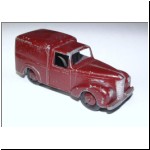 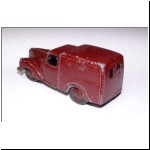  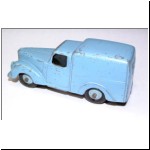 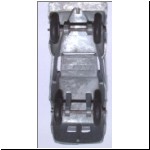
The Commer light van
was derived from the Hillman Minx car, and the
Minx Estate Car was the same shape as the van with the addition of a
side door and windows in the load area. The shape modelled by
Arro was used for the 1948 model year only. Earlier Minxes had
separate headlights, while for 1949 there was a complete re-design with
full-width body styling.
The Arro van
is not too bad as a model, in
fact the front view is very
good, but from the side it looks rather squashed, since the length and
height are out of proportion. The van is a single piece casting
with no baseplate. At the rear are two open windows, and ARRO is
cast under the roof. I have seen the van in pale blue, maroon, red and
light green colours. Sprayed silver trim was applied to the
radiator grille, headlights and front bumper.
Austin Seven
Racer
Length 77mm
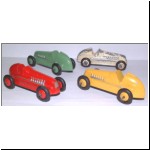 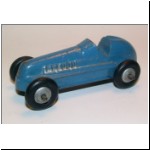 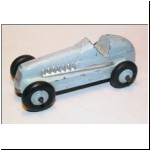
Again
the Arro is a
recognisable model, although not being an expert on
racing cars I will leave it to others to say how good it is. The
single piece casting has an exhaust pipe along each side, and ARRO is
cast under the driver's seat position. I have seen the racing car
in yellow, red, light green, off-white, blue or light grey.
Sprayed silver trim was
applied to the radiator grille and exhausts.
Both
Arro models are rare and difficult to find. It is a shame
that they didn't make anything else after such a promising start with
these two realistic toys.
Update
Previously
I updated this article with these photos of a catapult with the ARRO
name cast on it. I now think this is an American item and not
connected with the manufacturer of the diecast vehicles.
 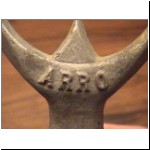
|









